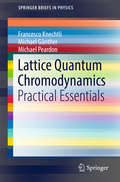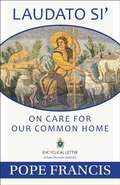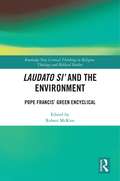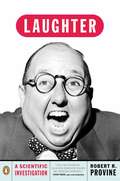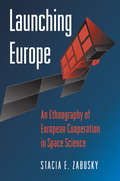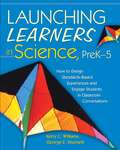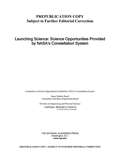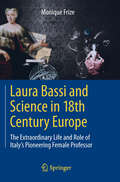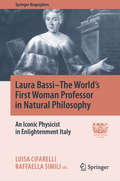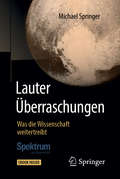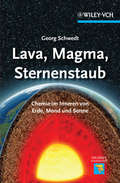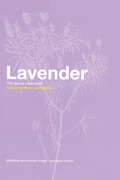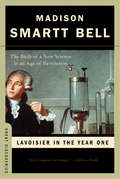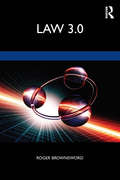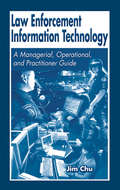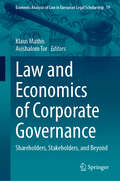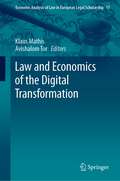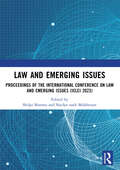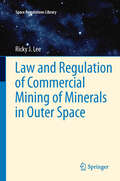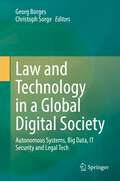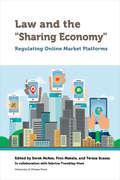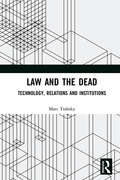- Table View
- List View
Lattice Quantum Chromodynamics
by Michael Günther Francesco Knechtli Michael PeardonThis book provides an overview of the techniques central to lattice quantum chromodynamics, including modern developments. The book has four chapters. The first chapter explains the formulation of quarks and gluons on a Euclidean lattice. The second chapter introduces Monte Carlo methods and details the numerical algorithms to simulate lattice gauge fields. Chapter three explains the mathematical and numerical techniques needed to study quark fields and the computation of quark propagators. The fourth chapter is devoted to the physical observables constructed from lattice fields and explains how to measure them in simulations. The book is aimed at enabling graduate students who are new to the field to carry out explicitly the first steps and prepare them for research in lattice QCD.
Laudato Si: On Care for Our Common Home
by Pope Francis<p><i>In the heart of this world, the Lord of life, who loves us so much, is always present. He does not abandon us, he does not leave us alone, for he has united himself definitively to our earth, and his love constantly impels us to find new ways forward. Praise be to him!</i> Pope Francis, <i>Laudato Si</i> <p>In his second encyclical, <i>Laudato Si: On Care of Our Common Home</i>, Pope Francis draws all Christians into a dialogue with every person on the planet about our common home. We as human beings are united by the concern for our planet, and every living thing that dwells on it, especially the poorest and most vulnerable. Pope Francis letter joins the body of the Church's social and moral teaching, draws on the best scientific research, providing the foundation for the ethical and spiritual itinerary that follows. <i>Laudato Si</i> outlines: <p> <li>The current state of our common home <li>The Gospel message as seen through creation <li>The human causes of the ecological crisis <li>Ecology and the common good <li>Pope Francis' call to action for each of us</li> <p> <p>Our Sunday Visitor has included discussion questions, making it perfect for individual or group study, leading all Catholics and Christians into a deeper understanding of the importance of this teaching.
Laudato Si’ and the Environment: Pope Francis’ Green Encyclical (Routledge New Critical Thinking in Religion, Theology and Biblical Studies)
by Robert McKimThis volume is a response to the Pope’s Laudato Si’, giving an interdisciplinary overview of its impact on the environmental concerns of Catholics as well as other religious groups. Published in 2015, it is often seen as an "environmental" encyclical and in it the Pope urges us to face up to the crisis of climate change. He argues that all of us should prioritise taking better care of the Earth, our common home, while also attending to the plight of the poor. Written by an international and multidisciplinary team of leading scholars, the Pope’s invitation to all people to begin a new dialog about these matters is considered from a variety of perspectives. There is discussion of the implications for immigration, population control, eating animals, and property ownership. Additionally, indigenous religious perspectives, development and environmental protection, and the implementation of the ideas of the encyclical in the Church are explored. Each chapter deals with the scriptural, theological, and philosophical underpinnings of the encyclical, as well as other central concepts such as interconnectedness, the role of practice, and what Pope Francis calls the "technocratic paradigm". This book expertly illuminates the relationship between Laudato Si’ and environmental concerns. It will, therefore, be vital reading for anyone studying religion and the environment, environmental ethics, Catholic theology, and environmental thought.
Laughter: A Scientific Investigation
by Robert R. ProvineWhy do we laugh? Laughter has surprisingly little to do with jokes and funny stories. It is an ancient, unconsciously controlled vocal relic that co-exists with our relatively modern speech - a social, psychological and biological act which predates humour and is sharedwith our primate cousins, the great apes. In this fascinating book Robert Provine uses laughter as a powerful probe into human social relationships, revealing that tickling is a form of tactilecommunication, not a reflex; that women laugh more at men than vice-versa; that speakers laugh more than their audiences; and that laughter is mostly about relationships, not jokes. Using the latest evidence, Provine describes laughter using sonic analysis and opera scores, evaluates whether you can 'laugh you way to health', considers what laughter shows about neuropathology, and suggests how to change environments to increase laughter. The first book to establish laughter as a topic of scientific worth, Laughter also includes such esoterica as the history of holy laughter, laughing gas, canned laughter, and a description of the Tanganyikan laughter epidemic that immobilized an entire school district in 1962.
Launching Europe: An Ethnography of European Cooperation in Space Science
by Stacia E. ZabuskyIn this first ethnographic study of the European Space Agency, Stacia Zabusky explores the complex processes involved in cooperation on space science missions in the contemporary context of European integration. Zabusky argues that the practice of cooperation does not depend on a homogenizing of interests in a bland unity. Instead, it consists of ongoing negotiation of and conflict over often irreconcilable differences. In this case, those differences are put into play by both technical and political divisions of labor (in particular, those of big science and of European integration). Zabusky shows how participants on space science missions make use of these differences, particularly those manifest in identities of work and of nationality, as they struggle together not only to produce space satellites but also to create European integration. She argues that the dialectical processes of production include and depend on conflict and contradiction to maintain energy and excitement and thus to be successful. Participants in these processes are not, however, working only to produce tangible success. In her epilogue, Zabusky argues that European space science missions can be interpreted as sacred journeys undertaken collectively, and that these journeys are part of a fundamental cultural project of modernity: the legitimation of and aspiration for purity. She suggests, finally, that this project characterizes not only the institution of technoscience but those of bureaucracy and nationalism as well.
Launching Learners in Science, PreK5: How to Design Standards-Based Experiences and Engage Students in Classroom Conversations
by Kerry C. Williams George E. VeomettThe only way to teach science is to do science. The combination of teaching and doing involves three elements: knowing content, teachers knowing and understanding themselves as teachers and learners, and, most importantly, knowing children. Kerry C. Williams and George E. Veomett describe principles and requirements that reflect the National Science Education Standards for the active learning of science. They brilliantly identify key ingredients for primary students and outline the best course of action to aid their development as young scientists.Using research on cognitive and neural development and motivational theory from the work of Piaget and Vygotsky, this is an invaluable tool for teachers inexperienced in science. It will help you discover new ways to think about science and develop lessons that are rich, fun, and authentic for both you and your students.All educators will find examples, questions, stories, and thought-provoking ideas to give students a strong start in science achievement, plus: Six key elements to build into science instruction: observing, representing, organizing, patterning and questioning, experimenting, and sharing How-to's for incorporating inquiry, workshops, centers, and projects in primary and elementary classrooms A four-step system-choice, planning, doing, reviewing-that helps promote learning in science and across all subjects
Launching Science: Science Opportunities Provided by NASA's Constellation System
by National Research Council of the National AcademiesIn January 2004 NASA was given a new policy direction known as the Vision for Space Exploration. That plan, now renamed the United States Space Exploration Policy, called for sending human and robotic missions to the Moon, Mars, and beyond. In 2005 NASA outlined how to conduct the first steps in implementing this policy and began the development of a new human-carrying spacecraft known as Orion, the lunar lander known as Altair, and the launch vehicles Ares I and Ares V. Collectively, these are called the Constellation System. In November 2007 NASA asked the National Research Council (NRC) to evaluate the potential for new science opportunities enabled by the Constellation System of rockets and spacecraft. The NRC committee evaluated a total of 17 mission concepts for future space science missions. Of those, the committee determined that 12 would benefit from the Constellation System and five would not. This book presents the committee's findings and recommendations, including cost estimates, a review of the technical feasibility of each mission, and identification of the missions most deserving of future study.
Laura Bassi and Science in 18th Century Europe: The Extraordinary Life and Role of Italy's Pioneering Female Professor
by Monique FrizeThis book presents the extraordinary story of a Bolognese woman of the settecento. Laura Maria Caterina Bassi (1711-1778) defended 49 Theses at the University of Bologna on April 17, 1732 and was awarded a doctoral degree on May 12 of the same year. Three weeks before her defense, she was made a member of the Academy of Sciences in Bologna. On June 27 she defended 12 additional Theses. Several of the 61 Theses were on physics and other science topics. Laura was drawn by the philosophy of Newton at a time when most scientists in Europe were still focused on Descartes and Galen. This last set of Theses was to encourage the University of Bologna to provide a lectureship to Laura, which they did on October 29, 1732. Although quite famous in her day, Laura Bassi is unfortunately not remembered much today. This book presents Bassi within the context of the century when she lived and worked, an era where no women could attend university anywhere in the world, and even less become a professor or a member of an academy. Laura was appointed to the Chair of experimental physics in 1776 until her death. Her story is an amazing one. Laura was a mother, a wife and a good scientist for over 30 years. She made the transition from the old science to the new very early on in her career. Her work was centered on real problems that the City of Bologna needed to solve. It was an exciting time of discovery and she was at the edge of it all the way.
Laura Bassi–The World's First Woman Professor in Natural Philosophy: An Iconic Physicist in Enlightenment Italy (Springer Biographies)
by Luisa Cifarelli Raffaella SimiliThis book provides a fascinating insight into the life and scientific work of Laura Bassi, the first female member of the influential Academy of Sciences of the Institute of Bologna and also the first woman to be appointed a university professor in physics, or universal philosophy as it was then termed. The book describes Laura Bassi’s research activities and achievements, explaining the influence of Newton, her role in promoting Newtonian experimental physics in Bologna, and her work as an experimentalist, including on electricity. Much attention is paid to the context in which Bassi developed her career. The very considerable difficulties faced by a woman surrounded by male university teachers and members of the Academy are discussed, casting light on the constraints that led Bassi to set up the first experimental physics laboratory in her home, complete with the many instruments required for experimentation and private teaching. The aim is to provide a rounded and well-documented account of the scientific endeavors and achievements of a too often overlooked scientist who struggled to overcome the prejudices of her age.
Lauter Überraschungen: Was die Wissenschaft weitertreibt
by Michael Springer„Springers Einwürfe“ – kritisch-amüsante Begleitungen des Forschungsbetriebs Nach Unendliche Neugier. Was die Wissenschaft treibt zeichnet eine weitere Auswahl aus "Springers Einwürfe" ab 2011 zusammen mit zwei längeren Essays ein buntes, abwechslungsreiches Bild des aktuellen Wissenschaftsbetriebs, seiner Resultate und Probleme. So entsteht ein laufender Kommentar, der einzelwissenschaftliche Erkenntnisse beschreibt, erklärt und in einen gesellschaftlichen Rahmen stellt. Im Vordergrund steht die Relevanz dieser und jener Entdeckung für die allgemeine Kultur: Schafft die Hirnforschung den freien Willen ab? Welche Wirklichkeit beschreibt die Quantenphysik? Werden Computer einmal Bewusstsein entwickeln? Durch die essayistische, anekdotische Form der größtenteils kurzen Beiträge ist Lesevergnügen garantiert.
Lava, Magma, Sternenstaub: Chemie im Inneren von Erde, Mond und Sonne (Erlebnis Wissenschaft)
by Georg SchwedtMehr als 9000 Meter tief im Erdinneren Genau 9101 Meter schaffte der Tiefbohrer in Windischeschenbach, dann versagte er aufgrund der großen Hitze von mehr als 300 Grad. Welche Schichten im Erdinneren stecken und wie diese beschaffen sind, das analysiert Georg Schwedt hier höchst anschaulich. Er reist entlang der „Deutschen Vulkanstraße“, und ganz nebenbei erfahren die Leser zum Beispiel, dass sie sich bei einer Hornhautbehandlung mit Bims die Füße mit dem Vulkangestein Magma schrubben. Unendliche Weiten oder die Chemie der Planeten Wie setzt sich der Schweif eines Kometen zusammen oder welche chemischen Bestandteile finden sich auf Sonne und Mond? Die Chemie der Planeten ist zwar schwer zu erforschen, aber dafür spannend und faszinierend – ranken sich doch um Venus, Saturn oder Mars Mythen aus alter Zeit und verbanden doch schon die Babylonier die Venus, den hellsten Wandelstern, mit den Göttinnen. Aristoteles und Galileo Galilei: Wie alles anfing Dieses Buch bietet die neusten Erkenntnisse über Erde und Universum, gleichzeitig aber auch einen sehr unterhaltsamen Rückblick auf die Anfänge der Wissenschaftsgeschichte. Von Aristoteles, der um 334 v. Chr. eine Theorie über die Kugelgestalt der Erde entwickelte, bis zu Galileo Galilei, der 1616 wegen seines Eintretens für das heliozentrische Weltbild von der Inquisition angeklagt wurde, entsteht hier ein buntes, spannendes Bild, das große Lust auf Wissenschaft macht.
Lavender: The Genus Lavandula (Medicinal and Aromatic Plants - Industrial Profiles)
by Maria Lis-BalchinLavandula species are mainly grown for their essential oils, which are used in perfumery, cosmetics, food processing and aromatherapy products, and for their use as ornamental plants and ingredients in numerous cottage industry products. Certain types of lavender oil have also been shown to have antimicrobial and antifungal properties. The dried fl
Lavoisier in the Year One: The Birth of a New Science in an Age of Revolution (Great Discoveries)
by Madison Smartt Bell"Fresh . . . solid . . . full of suspense and intrigue."--Publishers Weekly Antoine Lavoisier reinvented chemistry, overthrowing the long-established principles of alchemy and inventing an entirely new terminology, one still in use by chemists. Madison Smartt Bell's enthralling narrative reads like a race to the finish line, as the very circumstances that enabled Lavoisier to secure his reputation as the father of modern chemistry--a considerable fortune and social connections with the likes of Benjamin Franklin--also caused his glory to be cut short by the French Revolution.
Law 3.0: Rules, Regulation, and Technology
by Roger BrownswordPutting technology front and centre in our thinking about law, this book introduces Law 3.0: the future of the legal landscape. Technology not only disrupts the traditional idea of what it is ‘to think like a lawyer,’ as per Law 1.0; it presents major challenges to regulators who are reasoning in a Law 2.0 mode. As this book demonstrates, the latest developments in technology offer regulators the possibility of employing a technical fix rather than just relying on rules – thus, we are introducing Law 3.0. Law 3.0 represents, so to speak, the state we are in and the conversation that we now need to have, and this book identifies some of the key points for discussion in that conversation. Thinking like a lawyer might continue to be associated with Law 1.0, but from 2020 onward, Law 3.0 is the conversation that we all need to join. And, as this book argues, law and the evolution of legal reasoning cannot be adequately understood unless we grasp the significance of technology in shaping both legal doctrine and our regulatory thinking. This is a book for those studying, or about to study, law – as well as others with interests in the legal, political, and social impact of technology.
Law And Poverty
by Dr S. R. MyneniThe book Law and Poverty by Dr. S. R. Myneni provides a comprehensive exploration of the intricate relationship between legal frameworks and socio-economic issues related to poverty. It examines the definitions, causes, and measurements of poverty while addressing its impact on vulnerable groups such as women, children, and marginalized communities in India. The work delves into historical and modern theories of poverty, the politics surrounding it, and the international and domestic legal instruments aimed at its alleviation. Through detailed discussions on rights such as education, work, health, and shelter, the book emphasizes the importance of law in social justice and poverty eradication. It also critiques policies and suggests reforms, making it a valuable resource for understanding poverty's multidimensional aspects and the legal system's role in addressing them.
Law Enforcement Information Technology: A Managerial, Operational, and Practitioner Guide
by James ChuARE YOU PREPARED FOR THE LAW ENFORCEMENT IT REVOLUTION? Law enforcement agencies that are laggards in Information Technology (IT) will soon, if not already, be considered mismanaged. Whether you are in an operational position, or you are a police officer who aspires to a higher rank, you must be aware of how IT can help you perform your job and hel
Law and Economics of Corporate Governance: Shareholders, Stakeholders, and Beyond (Economic Analysis of Law in European Legal Scholarship #19)
by Klaus Mathis Avishalom TorThis book aims to analyse the principles and merits of CSR and ESG approaches using a law and economics perspective. The traditional law and economics view of corporate governance emphasises profit-maximisation and a shareholder-oriented approach. This perspective, famously endorsed by Milton Friedman, suggests that a business's sole social responsibility is to maximise profits within legal boundaries. Consequently, mainstream corporate governance scholarship has focused on structuring and regulating business organisations to achieve efficiency and minimise agency costs arising from diverging interests and asymmetric information among managers, shareholders, and creditors. However, recent decades have seen increased attention to the role and interests of other corporate stakeholders, such as employees, consumers, and communities. This shift includes the concept of corporate social responsibility (CSR), which addresses ethics-based issues like working conditions, human rights, fair competition, and environmental protection. While CSR has often been a form of self-regulation, regulatory schemes now support and incentivise this practice, promoting "stakeholderism" to enhance corporate reputation and profitability while ensuring social accountability. More recently, the focus on business sustainability has intensified under the banner of environmental, social, and governance (ESG) criteria. ESG considerations are now central in the corporate world, influencing ratings, investment decisions, and corporate strategies. Despite support from some scholars and institutions, critics argue that CSR and ESG may fail to benefit stakeholders and could impose high costs on businesses and the economy. Additionally, there are concerns about whether board members and managers are properly incentivised to protect stakeholder interests, as CSR and ESG can sometimes be used to avoid regulation or advance private interests.
Law and Economics of the Digital Transformation (Economic Analysis of Law in European Legal Scholarship #15)
by Klaus Mathis Avishalom TorThis book pursues the questions from a broad range of law and economics perspectives. Digital transformation leads to economic and social change, bringing with it both opportunities and risks. This raises questions of the extent to which existent legal frameworks are still sufficient and whether there is a need for new or additional regulation in the affected areas: new demands are made on the law and jurisprudence.
Law and Emerging Issues: Proceedings of the International Conference on Law and Emerging Issues (ICLEI 2023)
In the ever-evolving landscape of law and governance, adaptation and innovation are key to addressing the challenges of our times. This edited volume is a testament to the ever-evolving nature of the legal field and the ongoing efforts of legal scholars and academicians to dissect, analyze, and grapple with the challenges and opportunities presented by these changes. The topics covered in this book span a wide spectrum of legal domains, reflecting the complex and rapidly changing nature of our contemporary world. From corporate governance structures to emerging challenges in the digital space, from analyzing the implications of the Social Security Code 2020 in India to understanding the legal developments surrounding unorganized migrant workers during the COVID-19 pandemic, the breadth of subjects addressed here is both impressive and vital.
Law and Regulation of Commercial Mining of Minerals in Outer Space
by Ricky LeeThis monograph addresses the legal and policy issues relating to the commercial exploitation of natural resources in outer space. It begins by establishing the economic necessity and technical feasibility of space mining today, an estimate of the financial commitments required, followed by a risk analysis of a commercial mining venture in space, identifying the economic and legal risks. This leads to the recognition that the legal risks must be minimised to enable such projects to be financed. This is followed by a discussion of the principles of international space law, particularly dealing with state responsibility and international liability, as well as some of the issues arising from space mining activities. Much detail is devoted to the analysis of the content of the common heritage of mankind doctrine. The monograph then attempts to balance such interests in creating a legal and policy compromise to create a new regulatory regime.
Law and Society: An Introduction
by Cliff Roberson John Harrison WattsIn recent years, legal studies courses have increased the focus on contemporary social issues as part of the curriculum. Law and Society: An Introduction discusses the interface between these two institutions and encourages students in the development of new insights on the topic. The book begins by introducing definitions, classifications, and the
Law and Technology in a Global Digital Society: Autonomous Systems, Big Data, IT Security and Legal Tech
by Georg Borges Christoph SorgeThis book examines central aspects of the new technologies and the legal questions raised by them from both an international and an inter-disciplinary perspective. The technology revolution and the global networking of IT systems pose enormous challenges for the law. Current areas of discussion relate to autonomous systems, big data and issues surrounding legal tech. Ensuring data protection and IT security as well as the creation of a legal framework for the new technology as a whole can only be achieved through international and inter-disciplinary co-operation.The team of authors is made up of experienced, internationally renowned experts as well as young researchers and professionals who give valuable insights from numerous different jurisdictions. This book is written for jurists and those responsible for technology in public authorities and companies as well as practising lawyers and researchers.
Law and the "Sharing Economy": Regulating Online Market Platforms (Law, Technology and Media)
by Mariana Valverde Eric Tucker Michael Geist Harry Arthurs Francesco Ducci Marie-Cécile Escande-Varniol Vincent Gautrais Eran Kaplinsky Nofar Sheffi Sabrina Tremblay-HuetControversy shrouds sharing economy platforms. It stems partially from the platforms’ economic impact, which is felt most acutely in certain sectors: Uber drivers compete with taxi drivers; Airbnb hosts compete with hotels. Other consequences lie elsewhere: Uber is associated with a trend toward low-paying, precarious work, whereas Airbnb is accused of exacerbating real estate speculation and raising the cost of long-term rental housing. While governments in some jurisdictions have attempted to rein in the platforms, technology has enabled such companies to bypass conventional regulatory categories, generating accusations of “unfair competition” as well as debates about the merits of existing regulatory regimes. Indeed, the platforms blur a number of familiar distinctions, including personal versus commercial activity; infrastructure versus content; contractual autonomy versus hierarchical control. These ambiguities can stymie legal regimes that rely on these distinctions as organizing principles, including those relating to labour, competition, tax, insurance, information, the prohibition of discrimination, as well as specialized sectoral regulation. This book is organized around five themes: technologies of regulation; regulating technology; the sites of regulation (local to global); regulating markets; and regulating labour. Together, the chapters offer a rich variety of insights on the regulation of the sharing economy, both in terms of the traditional areas of law they bring to bear, and the theoretical perspectives that inform their analysis. Published in English.
Law and the Dead: Technology, Relations and Institutions
by Marc TrabskyThe governance of the dead in the eighteenth and nineteenth centuries gave rise to a new arrangement of thanato-politics in the West. Legal, medical and bureaucratic institutions developed innovative technologies for managing the dead, maximising their efficacy and exploiting their vitality. Law and the Dead writes a history of their institutional life in the nineteenth and twentieth centuries. With a particular focus on the technologies of the death investigation process, including place-making, the forensic gaze, bureaucratic manuals, record-keeping and radiography, this book examines how the dead came to be incorporated into legal institutions in the modern era. Drawing on the writings of philosophers, historians and legal theorists, it offers tools for thinking through how the dead dwell in law, how their lives persist through the conduct of office, and how coroners assume responsibility for taking care of the dead. This historical and interdisciplinary book offers a provocative challenge to conventional thinking about the sequestration of the dead in the nineteenth and twentieth centuries. It asks the reader to think through and with legal institutions when writing a history of the dead, and to trace the important role assumed by coroners in the governance of the dead. This book will be of interest to scholars working in law, history, sociology and criminology.
